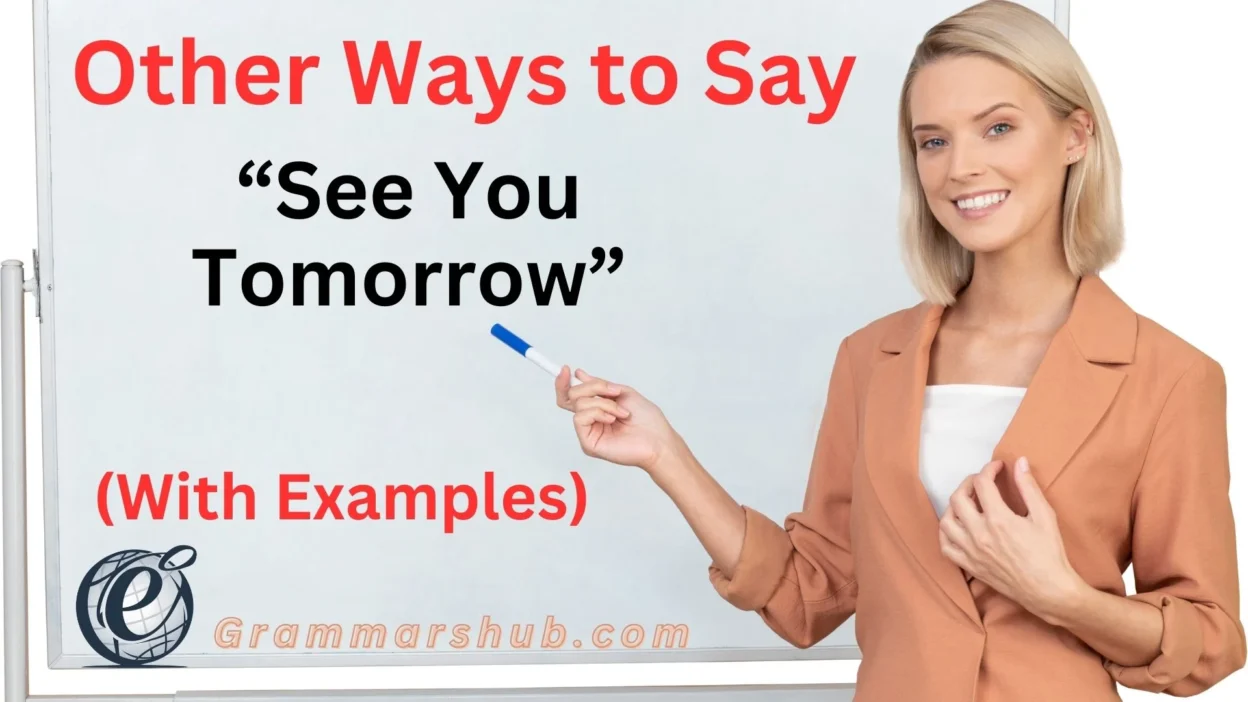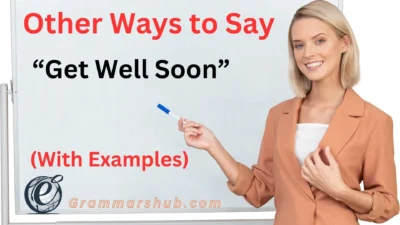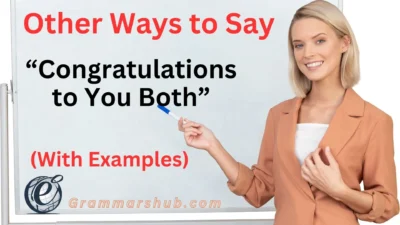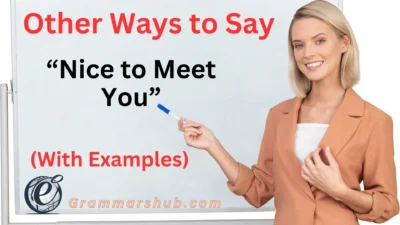The way we communicate has the power to shape relationships, and the phrases we use can convey warmth, care, and thoughtfulness. Whether it’s a casual chat with a friend, a professional exchange, or a heartfelt message, choosing the right words can make all the difference. Saying “See you tomorrow” is a simple way to let someone know you’ll be meeting them again soon, but there are many other ways to express this sentiment.
By adding variety to your vocabulary, you can make your goodbyes more personal, sincere, and engaging. Here are 35 alternative ways to say “See you tomorrow”, each with its own flavor and tone.
What Does “See You Tomorrow” Mean?
“See you tomorrow” is a common expression used to say goodbye to someone with the expectation of meeting them again the next day. It implies a casual, friendly farewell, indicating that you’ll be seeing them soon without specifying the exact time. It’s a warm way to show that you look forward to reconnecting.
Is It Professional/Polite to Say “See You Tomorrow”?
The phrase “See you tomorrow” is generally polite and appropriate in informal settings. In professional environments, however, depending on the context, it may be too casual. If you’re in a more formal situation or addressing someone in a professional setting, it might be more suitable to say something like “I look forward to seeing you tomorrow” or “I’ll see you at the meeting tomorrow.”
Advantages and Disadvantages
Advantages:
- It’s a friendly, reassuring phrase.
- It can be used in both casual and semi-formal settings.
- It implies a sense of continuity and connection.
Disadvantages:
- It can sound repetitive if used too often.
- It might not be as suitable in highly formal contexts.
1. Catch you tomorrow
Meaning: A casual way of saying goodbye, implying you’ll meet again tomorrow.
Explanation: This phrase is informal and friendly. It suggests that you’re looking forward to the next meeting.
Scenario Example: After a fun lunch with a colleague, you say, “Catch you tomorrow!”
Best Use: Best for casual settings, like with friends or coworkers you have a close relationship with.
Tone: Warm, friendly, and casual.
2. See you in the morning
Meaning: Implies you’ll see the person the next day, usually early.
Explanation: This is slightly more specific than “See you tomorrow,” as it suggests the meeting will happen in the morning.
Scenario Example: A colleague tells you, “See you in the morning,” after wrapping up an afternoon project.
Best Use: Good when you’re planning to meet early the next day.
Tone: Warm and specific.
3. Until tomorrow
Meaning: A more straightforward way of indicating you’ll see the person the next day.
Explanation: This expression is simple and to the point.
Scenario Example: A friend says, “Alright, until tomorrow!” before leaving a coffee shop.
Best Use: Casual, but can be used in semi-formal settings too.
Tone: Direct and optimistic.
4. Talk to you tomorrow
Meaning: Indicates that you’ll speak or communicate with the person tomorrow.
Explanation: This is often used in a communication context, especially with people you interact with regularly.
Scenario Example: After a phone call with a colleague, you say, “Talk to you tomorrow!”
Best Use: Perfect for phone calls or virtual conversations.
Tone: Friendly and informal.
5. See you soon
Meaning: A slightly more flexible way to say goodbye, implying that you’ll meet again soon, typically tomorrow.
Explanation: This phrase is used when you’re unsure about the exact time, but know you’ll meet again soon.
Scenario Example: You say, “See you soon!” as you leave the office for the day.
Best Use: When the exact time isn’t crucial, but you want to express that you will see the person shortly.
Tone: Light and optimistic.
6. I’ll catch you later
Meaning: A casual and informal way of saying goodbye, often used when parting ways for the day.
Explanation: While this can imply an indefinite time, it often refers to seeing someone again the next day.
Scenario Example: You say this to a friend as you leave a party.
Best Use: Casual and friendly settings.
Tone: Relaxed and informal.
7. Till tomorrow
Meaning: Shortened form of “until tomorrow,” conveying the same idea in a more succinct manner.
Explanation: It’s a quick, efficient way of saying you’ll meet the next day.
Scenario Example: As you leave work, you tell a colleague, “Till tomorrow!”
Best Use: Good for both casual and professional settings.
Tone: Friendly and straightforward.
8. Looking forward to tomorrow
Meaning: This phrase adds a note of excitement and anticipation about seeing the person the next day.
Explanation: It expresses eagerness, implying you’re excited about your next meeting.
Scenario Example: A colleague says, “Looking forward to tomorrow,” after discussing an exciting project.
Best Use: When you want to express enthusiasm about your upcoming plans.
Tone: Positive, eager.
9. See you bright and early
Meaning: A more specific phrase, usually used when you plan to meet first thing in the morning.
Explanation: It adds energy and suggests an early meeting, often associated with the start of a productive day.
Scenario Example: You tell your colleague, “See you bright and early!” as you leave the office for the night.
Best Use: When you have plans early the next day.
Tone: Positive, energetic.
10. Till then
Meaning: A slightly more casual way of saying goodbye until you meet again, usually tomorrow.
Explanation: It can be used to close a conversation with the understanding that you’ll reconnect soon.
Scenario Example: A friend says, “Till then,” after finalizing plans for the next day.
Best Use: Casual and informal interactions.
Tone: Casual, relaxed.
11. See you on the flip side
Meaning: A quirky and fun way of saying goodbye with the idea of meeting again soon.
Explanation: This expression is informal and adds a bit of humor.
Scenario Example: You say this to a friend after hanging out, “See you on the flip side!”
Best Use: Best for casual settings with friends or people you have a lighthearted relationship with.
Tone: Fun and energetic.
12. I’ll see you then
Meaning: A way to indicate you’ll meet at a specific time, usually tomorrow.
Explanation: This phrase feels definitive, marking the next time you’ll see the person.
Scenario Example: After making plans for the next day, you confirm, “I’ll see you then!”
Best Use: When you have specific plans for the next day.
Tone: Confident and clear.
13. Have a great night, see you tomorrow
Meaning: A warm farewell, wishing the person a good night while indicating you’ll see them the next day.
Explanation: This adds an extra layer of care and well-wishing.
Scenario Example: You say this to a coworker as you leave the office at night.
Best Use: When you want to express warmth and care.
Tone: Caring and considerate.
14. Can’t wait for tomorrow
Meaning: Expresses excitement and anticipation for the upcoming day.
Explanation: This phrase shows that you’re looking forward to your meeting tomorrow.
Scenario Example: After a fun conversation, you say, “Can’t wait for tomorrow!”
Best Use: When you’re genuinely excited about the next day.
Tone: Enthusiastic, positive.
15. See you at the usual time
Meaning: Indicates that you’ll meet at the same time as usual, often tomorrow.
Explanation: This is practical and assumes that you meet regularly.
Scenario Example: You tell your coworker, “See you at the usual time,” as you part ways.
Best Use: For routine meetings or appointments.
Tone: Comfortable and familiar.
16. Until we meet again tomorrow
Meaning: A slightly formal and heartfelt way of saying you’ll see someone the next day.
Explanation: This phrase adds a poetic and thoughtful touch to a simple farewell.
Scenario Example: After a deep conversation, you say, “Until we meet again tomorrow.”
Best Use: Suitable for heartfelt goodbyes or semi-formal settings.
Tone: Warm and sentimental.
17. Tomorrow it is!
Meaning: A confident way of confirming a meeting or plan for the next day.
Explanation: This phrase adds excitement and certainty about the next day.
Scenario Example: A friend suggests meeting at the café, and you respond, “Tomorrow it is!”
Best Use: When confirming plans in an upbeat manner.
Tone: Enthusiastic and friendly.
18. Rest well, see you tomorrow
Meaning: A caring way to wish someone a good night while confirming you’ll see them the next day.
Explanation: This farewell expresses concern for the person’s well-being while reminding them of your meeting.
Scenario Example: After a long day, you say, “Rest well, see you tomorrow.”
Best Use: Best for close friends, family, or coworkers after a tiring day.
Tone: Warm and caring.
19. Same time, same place
Meaning: A fun and slightly playful way of confirming plans for the next day.
Explanation: This phrase assumes a set routine and adds a lighthearted tone.
Scenario Example: You and a coworker always grab coffee before work, so you say, “Same time, same place?”
Best Use: When referring to regular plans with someone.
Tone: Playful and familiar.
20. Until next time (which is tomorrow!)
Meaning: A slightly dramatic or humorous way to say you’ll see someone again soon.
Explanation: This phrase adds a little suspense or playfulness.
Scenario Example: A friend jokes, “Until next time… which is tomorrow!” before heading out.
Best Use: Best for fun, lighthearted interactions.
Tone: Playful and humorous.
21. Tomorrow can’t come soon enough!
Meaning: Expresses excitement about the next day.
Explanation: This phrase suggests that you’re eagerly anticipating seeing the person again.
Scenario Example: After planning a fun event, you say, “Tomorrow can’t come soon enough!”
Best Use: When looking forward to something exciting.
Tone: Excited and positive.
22. See you first thing tomorrow
Meaning: Specifies that you’ll be meeting early in the morning.
Explanation: This phrase works well when discussing work or planned events.
Scenario Example: Your boss says, “See you first thing tomorrow” before heading out.
Best Use: Ideal for professional and casual settings.
Tone: Straightforward and professional.
23. Have a good one, see you tomorrow
Meaning: A relaxed and friendly way of saying goodbye while wishing someone well.
Explanation: “Have a good one” is a casual farewell that pairs nicely with “see you tomorrow.”
Scenario Example: Leaving work, you tell your coworker, “Have a good one, see you tomorrow!”
Best Use: Great for casual interactions.
Tone: Friendly and easygoing.
24. Take care, see you tomorrow
Meaning: A caring way to say goodbye while ensuring the person stays safe.
Explanation: “Take care” adds a thoughtful touch to your farewell.
Scenario Example: As your friend heads home, you say, “Take care, see you tomorrow.”
Best Use: Perfect for friends, family, or coworkers.
Tone: Warm and caring.
25. See you bright and early tomorrow
Meaning: Reinforces an early morning meeting.
Explanation: This phrase is ideal for setting an expectation of an early start.
Scenario Example: A coach tells their team, “See you bright and early tomorrow for practice.”
Best Use: Best when scheduling an early appointment or work session.
Tone: Energetic and positive.
26. I’ll see you soon enough
Meaning: A casual, slightly playful way of saying goodbye.
Explanation: It expresses that the next meeting will happen soon.
Scenario Example: A friend teases, “I’ll see you soon enough!” as they leave.
Best Use: Great for informal conversations.
Tone: Lighthearted and playful.
27. I’ll see you when I see you (which is tomorrow!)
Meaning: A humorous way to say goodbye while confirming your meeting.
Explanation: This phrase can be playful or sarcastic, depending on tone.
Scenario Example: You joke with a friend, “I’ll see you when I see you… which is tomorrow!”
Best Use: Best for casual, friendly settings.
Tone: Playful and fun.
28. I’ll catch you in the AM
Meaning: A relaxed, informal way of saying you’ll see someone in the morning.
Explanation: “AM” refers to the morning hours.
Scenario Example: A friend texts, “I’ll catch you in the AM!” before heading to bed.
Best Use: Best for texting or casual speech.
Tone: Chill and modern.
29. See you before you know it!
Meaning: A reassuring way to say goodbye, suggesting that time will pass quickly.
Explanation: This phrase can be used to ease the feeling of a temporary goodbye.
Scenario Example: As you leave a meeting, you say, “See you before you know it!”
Best Use: Works well for both personal and professional interactions.
Tone: Reassuring and friendly.
30. Till we meet tomorrow
Meaning: A poetic way of saying “See you tomorrow.”
Explanation: This phrase adds a touch of formality and thoughtfulness.
Scenario Example: A professor tells their students, “Till we meet tomorrow, have a great evening.”
Best Use: Best for formal or literary settings.
Tone: Elegant and refined.
31. See you when the sun comes up
Meaning: A poetic way to indicate you’ll meet in the morning.
Explanation: This phrase paints a picture of an early morning reunion, adding warmth and charm to a simple goodbye.
Scenario Example: Before heading home from work, you tell a colleague, “See you when the sun comes up!”
Best Use: Best for early morning plans or when you want to sound more expressive.
Tone: Poetic and friendly.
32. See you at sunrise
Meaning: A creative way to say you’ll meet early in the morning.
Explanation: This phrase is often used humorously or when scheduling something at dawn.
Scenario Example: Your gym buddy says, “See you at sunrise for our morning run!”
Best Use: Ideal for plans happening at sunrise or for adding a dramatic flair.
Tone: Playful and dramatic.
33. Meet you on the other side of the night
Meaning: A unique and poetic way to indicate you’ll see the person tomorrow.
Explanation: This phrase creatively suggests that after the night passes, you’ll reunite.
Scenario Example: As you leave a late-night conversation, you say, “Meet you on the other side of the night.”
Best Use: Works well in poetic or deep conversations.
Tone: Thoughtful and poetic.
34. See you in 24 hours
Meaning: A playful, numerical way to say “See you tomorrow.”
Explanation: It gives a precise but casual feel to your farewell, making it stand out from the usual expressions.
Scenario Example: After scheduling a meeting, you say, “Alright, see you in 24 hours!”
Best Use: Great for informal and slightly humorous interactions.
Tone: Playful and lighthearted.
35. Let’s do this again tomorrow
Meaning: Suggests excitement or a continuation of an activity the next day.
Explanation: This phrase is commonly used after a fun or productive day, implying eagerness to repeat the experience.
Scenario Example: After a successful work session, you tell your teammate, “Let’s do this again tomorrow!”
Best Use: Perfect when wrapping up a productive or fun time with someone.
Tone: Enthusiastic and positive.
Conclusion
Saying “See you tomorrow” doesn’t have to be repetitive. With these 35 creative alternatives, you can make your farewells feel warmer, more engaging, and more personal. Whether you want to be funny, caring, professional, or casual, there’s an option for every situation. So, next time you part ways with someone, choose a phrase that adds a little extra thoughtfulness to your goodbye!




